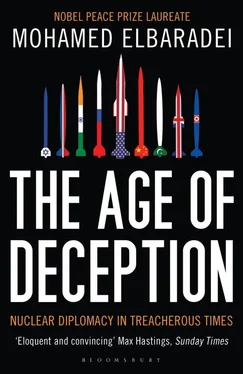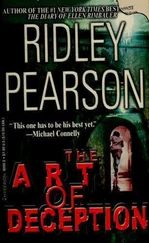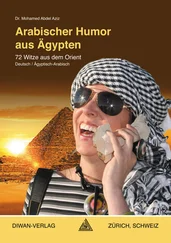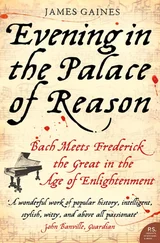The Swiss prepared a paper that laid out the lines under discussion. Despite signals from American officials indicating they did not want outside interference, Ambühl presented the paper to Larijani in Tehran. [6] The late 2010 WikiLeaks release of cables made clear that Washington was extremely unhappy with the Swiss attempts to work with Iran toward a solution. “U.S. Irked By Over-Eager Swiss Diplomats,” Mathieu van Rohr, Spiegel Online International, December 14, 2010.
I sent word to Larijani that this was likely the last chance for Iran to avoid another provocative Security Council resolution. The Swiss then tried every argument they could come up with to convince Iran of the benefits of going into full suspension. But to no avail: the Iranians would agree only to a two-stage process, in which they would freeze their enrichment activities—that is, not expand them further—for thirty days of “prenegotiation” during which the parties would jointly determine the “scope” of the double time-out to follow. This time-out would then go into effect for six months while the actual negotiations took place. This was a concession on Iran’s part, but it was not enough.
Larijani warned me that if the Security Council passed another resolution, Iran would break off the ongoing IAEA inspections at Natanz. This would be another case of noncompliance, I told him, and could only worsen the standoff. “I know the implications,” Larijani said, but the decision was coming from the Iranian government. He had tried to delay this action for six months but would not be able to do so any longer.
In the midst of all the diplomatic commotion, Iran continued to build its uranium enrichment capacity. When our inspectors visited Natanz on March 20, they saw that Iran had installed a total of one thousand centrifuges. It was both ironic and distressing to recall that just one year earlier the buildup of Iran’s enrichment program could have been halted at thirty to forty centrifuges. The American argument that Iran should be prevented from having enrichment knowledge was water under the bridge: Iranian nuclear specialists had now been running small cascades of centrifuges for more than a year.
Against this background, I prepared my report on Iran for the IAEA’s March Board meeting. Larijani’s deputy, Javad Vaeedi, had recently given an interview in which he claimed, falsely, that a comment in my previous report—that the IAEA was not in a position to verify the peaceful nature of Iran’s program—had been “embedded” by the U.S. ambassador to the Agency. This made me angry: the Agency had gone out of its way to work with the Iranians objectively and professionally. For Iran to question our integrity was unacceptable.
I decided, in my current report, to be quite blunt: Indeed the IAEA could not reach any verdict on the Iranian program. Iran’s position, I wrote, was sui generis; Iran had cheated on their reporting obligations for twenty years. As a result, we had no choice but to reconstruct the full history of their program. Until they responded to our questions and concerns with conclusive and satisfactory explanations, they would remain in the defendant’s box.
The Board meeting took place amid much tension. A draft Security Council resolution with sanctions was in the pipeline. Abdul Minty, South Africa’s governor on the Board, briefed me on the diplomatic efforts they, too, were making in the Security Council. The United States and the EU-3 would have preferred that South Africa and President Thabo Mbeki, with the weight they carried among developing countries, refrain from trying to find a solution on Iran. But South Africa was keen to play a role. Together with Switzerland, South Africa was ready to engage in an effort to resolve the Iran nuclear issue through negotiation and dialogue in accordance with the tenets of the NPT. In addition, South Africa held a seat on the Security Council and was not afraid to use it. Although the P-5+1 tended to dominate the proceedings, the South African ambassador in New York, Dumisani Kumalo, had declared to the council that his country was not there merely as window dressing.
I told Minty that, unless a breakthrough occurred soon, I believed we were heading toward a train wreck. He said he would speak to his government colleagues, and the very next day South Africa submitted a series of amendments to the draft Security Council resolution. These included the call for a ninety-day time-out. They adjusted the proposed sanctions to focus on the nuclear program. They clarified that any decision to lift a suspension would be based on the IAEA’s technical judgment and not the council’s political judgment.
The South African amendments could have created problems for the Western powers, who were intent on having the resolution adopted unanimously. The P-5+1 ignored South Africa’s proposals in public but began acting immediately behind the scenes to exert pressure on the other governments—as well as on Johannesburg—to vote in favor of the unaltered resolution. Their tactics worked; Minty called me the day before the resolution’s adoption to say that none of the eight other members of the council had spoken up in support of the proposed amendments. In the end, South Africa’s efforts had only delayed the inevitable.
The Security Council adopted Resolution 1747 by unanimous vote on March 24, 2007, calling once again on Iran to comply with suspension of its enrichment program. Sanctions included banning Iran’s arms imports and exports, freezing assets, and restricting the travel of individuals engaged in the country’s nuclear activities. British ambassador Sir Emyr Jones-Parry read a statement on behalf of the P-5+1 expressing readiness to continue talks with Iran. The statement included ideas on restarting negotiations based on the language I had proposed. Of course, my suggestion had been to present these ideas to Iran in confidence, before adopting a resolution, not publicly, in conjunction with punishment.
Interestingly, Jones-Parry’s statement claimed that the resolution’s purpose was to “eliminate the possibility of Iran acquiring a nuclear-weapon capability.” This was a far cry from previous language, used by the United States and others, which had expressed certainty that Iran already had a nuclear weapon program—a certainty that rested, as Jack Straw had once put it, on “not a whiff” of proof. [7] As described in chapter 5, I had gotten into a public spat with the Americans in the November 2003 Board meeting, because of their anger when I said that we had not seen evidence linking Iran’s nuclear material or activities to a nuclear weapons program.
From this point on, the Americans shifted their vocabulary to speak only of Iran’s nuclear weapon “ambitions” or “intentions.” It was small comfort.
By mid-May 2007, our inspectors had determined that the Iranians had installed a total of ten 164-centrifuge cascades in the underground industrial enrichment facility at Natanz. Three more cascades were under construction. An additional two cascades were running above ground, in the pilot plant.
According to Olli Heinonen, Iran had achieved its explicit goal of enriching uranium up to 5 percent. Our experts considered that the Iranians had acquired most of the knowledge needed for enrichment. And the pace of expansion was increasing. “They are now installing one cascade per week,” Olli said. “By our estimation, if they keep up this pace, they will have three thousand centrifuges in place by the end of June, and eight thousand by Christmas.” This would put the Iranians well on the way to industrial enrichment capacity. Obviously, they no longer saw a purpose in holding back.
At this point, I envisioned four possible futures for Iran’s nuclear program, which I had the opportunity to lay out explicitly at a meeting in Spain with Prime Minister José Zapatero and his foreign minister Miguel Moratinos.
Читать дальше












